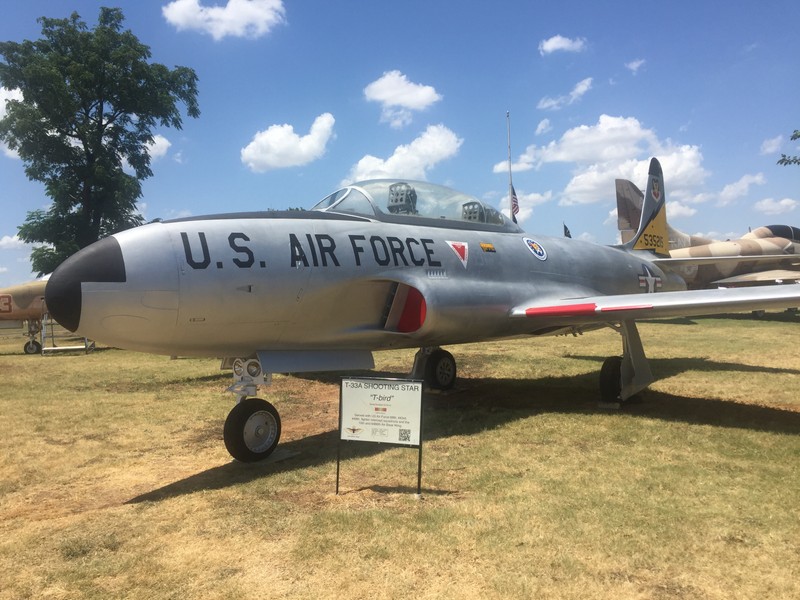Lockheed T-33A Shooting Star
Introduction
Text-to-speech Audio
Images
Lockheed T-33A Shooting Star "Spittin Kittins"

Backstory and Context
Text-to-speech Audio
The Fort Worth Aviation Museum’s Lockheed T-33A is the oldest jet in the our collection. Specifically, it is a Lockheed T-33A-1-LO Shooting Star, Air Force Serial No. 53-5215, c/n 580-8554, manufactured by Lockheed at Burbank, California, and delivered to the USAF on 20 September 1954.
It went immediately to the Sacramento Air Material Center, California, for modifications. In November 1954, the aircraft was assigned to the Alaskan Air Command’s 66th Fighter Interceptor Squadron at Elmendorf Air Force Base, Alaska.
The following month, it was assigned to the 449th Fighter Interceptor Squadron (FIS) at Ladd AFB, Alaska.
In February 1955, the aircraft went to the 5001st Operations Squadron also at Ladd AFB. During March 1955, the T-33 was assigned to the 433rd Fighter Interceptor Squadron again at Ladd AFB. In November 1955, the aircraft returned to Elmendorf AFB and went to the 5039th Aircraft Repair Squadron. A month later, the aircraft was back with the 433rd Fighter Interceptor Squadron at Ladd AFB.
In August 1956, the aircraft returned to the 5039th Maintenance Squadron at Elmendorf AFB. In December 1956, the aircraft was assigned to the 5001st Operations Squadron at Ladd AFB. In November 1957, the aircraft was assigned to the 5060th Operations Squadron also at Ladd. In April 1958, the T-33 went to the 5060th Consolidated Logistics And Maintenance Group at Ladd.
In October 1964, the aircraft was sent to Lear-Siegler at Elmendorf AFB. The following month, the aircraft was operating with the 5040th Consolidated Logistics And Maintenance Group also at Elmendorf AFB. In October 1966, the aircraft returned to the Sacramento Air Material Area, California, for work. In January 1967, the aircraft joined the Pacific Air Forces and the 6486th Air Base Wing at Hickam AFB, Hawaii. In November 1971, the aircraft went to the 15th Air Base Wing also at Hickam Field. In March 1973, the T-33 was removed from the USAF inventory.
Following military service the aircraft was at Honolulu Community College from 1973 until 1988 and carried the civil registration of N8361. It was later owned by Jack A. Myers and John C. Macidull circa 1988 and then to the Coleman Warbirds Museum in Coleman, Texas, 1990-1992. Dixie Air Parts in San Antonio acquired the aircraft, 1991-1992. David Clark and Adam Galan of Arlington, Texas, acquired the aircraft August 1993. In December 2003, the Texas Air Command Museum purchased the aircraft. The Fort Worth Aviation Museum acquired the aircraft in [date].
Locally, T-33s were assigned to most military units as utility aircraft and trainers. They were in service for decades.
Sources
Fort Worth Aviation Museum
Fort Worth Aviaiton Museum
